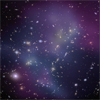CXC Home | Search | Help | Image Use Policy | Latest Images | Privacy | Accessibility | Glossary | Q&A
Tour of MacsJ0717
Quicktime MPEG
This image contains one of the most complex galaxy clusters known, which is located about 5.4 billion light years from Earth. In this system known as MacsJ0717 for short, 4 separate galaxy clusters have collided. This is the first time such a complex crash of galaxy clusters has been documented. In this composite image, data from the Chandra X-ray Observatory reveal the cluster's hot gas, while an optical image from the Hubble Space Telescope shows the individual galaxies in the system. The gas in this image is color-coded to show temperature, just like a weather map for Earth. In this case however, the temperatures range from millions to tens of millions of degrees, where the coolest gas here is colored red, the hottest gas is blue, and the temperatures in between are purple.
[Runtime: 00:51]
Quicktime MPEG
This image contains one of the most complex galaxy clusters known, which is located about 5.4 billion light years from Earth. In this system known as MacsJ0717 for short, 4 separate galaxy clusters have collided. This is the first time such a complex crash of galaxy clusters has been documented. In this composite image, data from the Chandra X-ray Observatory reveal the cluster's hot gas, while an optical image from the Hubble Space Telescope shows the individual galaxies in the system. The gas in this image is color-coded to show temperature, just like a weather map for Earth. In this case however, the temperatures range from millions to tens of millions of degrees, where the coolest gas here is colored red, the hottest gas is blue, and the temperatures in between are purple.
[Runtime: 00:51]
(Credit: X-ray (NASA/CXC/IfA/C. Ma et al.); Optical (NASA/STScI/IfA/C. Ma et al.))
Images of MACSJ0717
Quicktime MPEG
These composite Chandra X-ray Observatory and Hubble Space Telescope images show the massive galaxy cluster MACSJ0717.5+3745 where four separate galaxy clusters have been involved in a collision -- the first time such a phenomenon has been documented. X-rays from Chandra reveal the cluster's hot gas, while optical data show the individual galaxies in the system. The colors show the varying temperatures found in the hot gas, where the coolest gas is reddish purple, the hottest gas is blue, and the temperatures in between are purple.
[Runtime: 00:24]
View Stills
Quicktime MPEG
These composite Chandra X-ray Observatory and Hubble Space Telescope images show the massive galaxy cluster MACSJ0717.5+3745 where four separate galaxy clusters have been involved in a collision -- the first time such a phenomenon has been documented. X-rays from Chandra reveal the cluster's hot gas, while optical data show the individual galaxies in the system. The colors show the varying temperatures found in the hot gas, where the coolest gas is reddish purple, the hottest gas is blue, and the temperatures in between are purple.
[Runtime: 00:24]
View Stills
(Credit: X-ray (NASA/CXC/IfA/C. Ma et al.); Optical (NASA/STScI/IfA/C. Ma et al.))
Animation of Galaxy Cluster
Quicktime MPEG
This animation shows a galaxy cluster, the largest gravitationally-bound objects in the Universe. Individual galaxies are shown in white and yellow, and the intergalactic gas is shown in red. Galaxy clusters contain as much mass as a million billion suns. The strong gravitational pull of this matter squeezes the gas and heats it to about 100 million degrees, making it only detectable in X-rays. Collisions of multiple galaxy clusters are responsible for the system seen today in MACSJ0717.
[Runtime: 00:26]
Quicktime MPEG
This animation shows a galaxy cluster, the largest gravitationally-bound objects in the Universe. Individual galaxies are shown in white and yellow, and the intergalactic gas is shown in red. Galaxy clusters contain as much mass as a million billion suns. The strong gravitational pull of this matter squeezes the gas and heats it to about 100 million degrees, making it only detectable in X-rays. Collisions of multiple galaxy clusters are responsible for the system seen today in MACSJ0717.
[Runtime: 00:26]
(Credit: NASA/CXC/A.Hobart)
Return to MACSJ0717.5+3745 (April 16, 2009)





